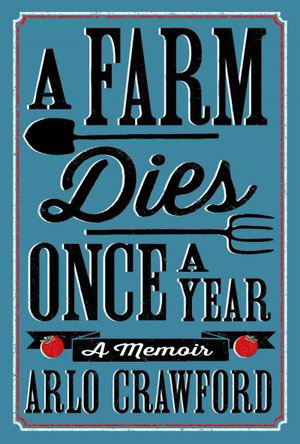A Farm Dies Once A Year
by Arlo Crawford
reviewed by Virginia Marshall
Tomato plants should be staked six feet apart. Okra pods must be carefully clipped loose from their stalks and can cause rashes on skin. Squash plants are tough and grow low to the ground. These are not facts I can normally dredge out of my suburban brain, but Arlo Crawford’s debut memoir A Farm Dies Once A Year taught me a thing or two about vegetables.
Crawford begins his memoir as a thirty-something-year-old hipster living in Cambridge, more artist than farmer. He decides to spend about six months working on his parents’ farm in Pennsylvania “to appreciate all the ways it could make me feel happy” and ends up digging through memories of a childhood spent on tractor seats and at farmers’ markets. Crawford studies his parents as both participant and observer, letting his relationship with their vocation mature as the book progresses.
For the most part, Crawford relishes the quaint, day-to-day pleasure of the farm as he notices “the way my mother called the dogs to come with her when she went to pick broccoli” and “how my father squeezed an ear of corn to see if it was ready, and then shucked it and ate it raw.” But amid this nostalgia there is a deeper urge, an instinct to define himself in the landscape of his childhood.
This is illustrated quite beautifully when Crawford decides to build himself a house on the edge of his parents’ property. At first he is bemused by the technical and physical aspects of the job, but as he continues to build, he writes, “I was starting to enjoy how the structure balanced against itself, how it was all one piece.” Crawford becomes, as he puts it, “a little giddy, singing out loud and beating the nails in harder than I needed to” as his home nears completion. Standing back to survey his small feat of architecture, his language seems to hint at the process of composing the memoir itself: “It was articulated and graceful, and it was strange-looking. It looked exactly like what I’d pictured in my mind when I’d first set out.”
Even with this youthful enthusiasm, Crawford does not shy away from the less picturesque details of farm life, which he plants throughout the narrative: the irrigation system clogged with a dead, pulverized mouse; chickens devouring a broken egg; the back-breaking, assembly-line work of picking squash in the hot sun. Nor does he expect the reader to necessarily understand the impact of these small catastrophes: that one rough tomato blight can cause a small farm to lose $100,000; or that basil plants can wilt within hours of being cut. Crawford walks us through the agricultural nuances patiently, detailing the science and economics behind life on the farm.
Because the emotional depth of the memoir is so intertwined in the narrator’s relationship with his family’s land and their story, moments spent away from New Morning Farm feel superfluous, as when Crawford rediscovers the details of a homicide that took place on the neighboring farm. He becomes fixated on researching the death of this man, his father’s good friend and, though interesting and well-written, this plot line feels like the wanderings of a writer who does not trust his central narrative to hold up without the momentum generated by a murder.
In fact, the memoir thrives on its narrator’s careful honesty as he establishes the environment and then breaks down appearances. In one touching moment, Crawford describes a picture in his father’s office of him as a four-year-old, sitting on a tractor: “It’s a picture that a lot of farmers take of their kids, a reminder of a childhood full of sun and playing in the fields and fresh vegetables.” Having established the background, Crawford makes one more adjustment to the photo: “The truth was that I had always felt more ambivalent about the farm than that picture might have let on.” What Crawford does with this photo is an illustration of the unique way in which he attempts to tell his story: first by establishing the scene, then digging deeper for details, turning over assumptions, planting a new conception of the scene, and eventually producing what he feels is a prime example of how to make a living.
Published on August 20, 2014

